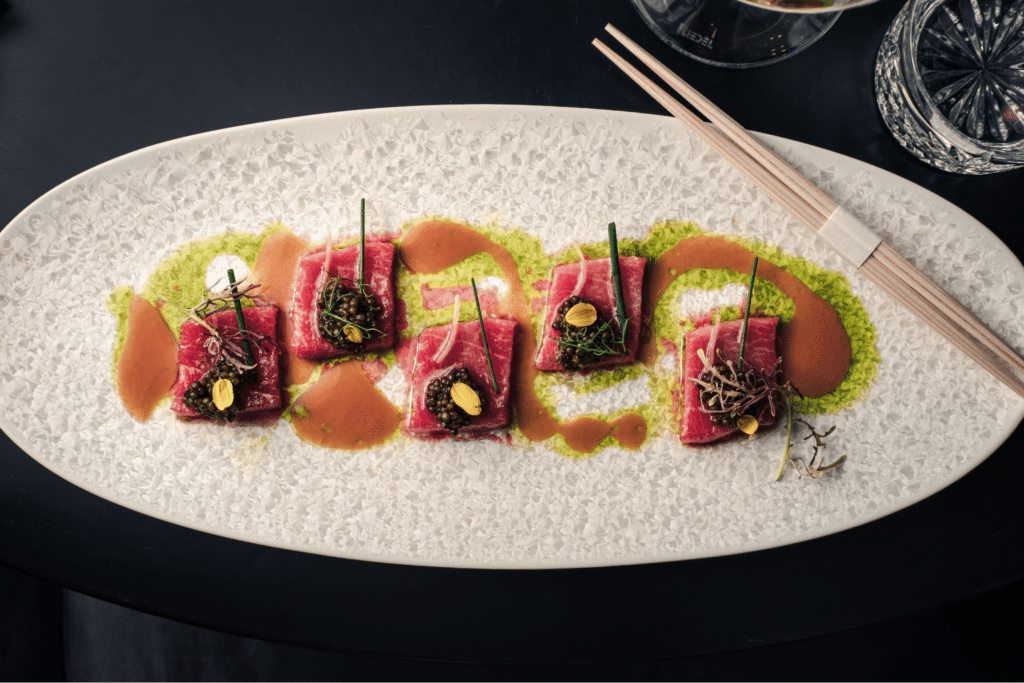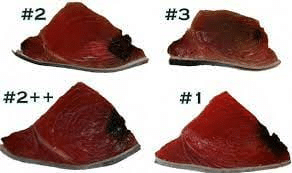Seafood 101:
Understanding the Different Grades of Tuna
Have you ever wondered what makes one piece of tuna better than another? When it comes to seafood, particularly tuna, different grades are used to distinguish the quality and flavor profile of the fish. Understanding these superior grades can greatly elevate your culinary experience. Whether you’re a seasoned aficionado or a curious beginner in seafood appreciation, join us as we deep dive into the diverse spectrum of tuna grades and this prized ocean delicacy.
What are the benefits of tuna?

The benefits of tuna are numerous due to its nutrient-rich composition. It is an excellent source of high-quality protein, which helps build and repair tissues in the body. Additionally, tuna is packed with omega-3 fatty acids that promote heart health by reducing inflammation and lowering blood pressure.
Omega-3s also play a crucial role in brain function and can improve cognitive performance. Tuna contains significant amounts of essential vitamins like B12 and D and minerals such as selenium and potassium. These nutrients contribute to maintaining healthy bones, supporting immune function, and regulating blood pressure levels and metabolism.
Furthermore, tuna is relatively low in calories and rich in essential nutrients. This makes it an ideal choice for individuals striving for weight management or healthier eating habits.
What color is tuna?
Tuna typically has a deep, vibrant red color, especially in its raw form. This rich hue is indicative of its freshness and high quality. However, once cooked, tuna can vary in color depending on the preparation method and doneness level.
It can range from pale pink to light brown or grayish-white. The final color of cooked tuna largely depends on factors such as heat exposure and the timing of cooking.
Is tuna safe to eat raw?
Tuna can be safe to eat raw, but it’s important to exercise caution and choose high-quality tuna specifically intended for raw consumption. When consuming raw tuna, the fish must be handled properly throughout its journey from sea to plate.
To ensure safety, purchasing sushi-grade or sashimi-grade tuna from reputable sources is recommended. These grades are typically selected based on stringent quality standards and undergo careful handling and storage processes to minimize bacterial contamination.
Enjoy the best seafood and more on the Vegas Strip today.
What is sushi-grade tuna?
Sushi-grade tuna refers to a specific designation given to fish that meets the criteria for safe consumption in raw or lightly cooked preparations, such as sushi or sashimi. It generally implies that the tuna has been handled and processed under strict sanitary conditions to minimize potential risks associated with consuming raw seafood.
Sushi-grade tuna is typically sourced from high-quality, fresh catches of larger species like yellowfin (ahi) or bigeye tunas.
Sushi or sashimi? What is the difference?
While both sushi and sashimi are traditional Japanese dishes featuring raw fish, they differ in their preparation and presentation:
Sushi
Sushi is a dish that consists of vinegared rice combined with various ingredients such as seafood (including raw or cooked fish), vegetables, and sometimes even egg. The rice acts as the base and is usually seasoned with sugar, salt, and vinegar.
The ingredients are then placed on top of or rolled within the rice using seaweed sheets (nori) or served as individual pieces called nigiri. Sushi can be enjoyed with accompaniments like soy sauce, wasabi, and pickled ginger.
Sashimi
In contrast to sushi, sashimi refers specifically to thin slices of raw fish or seafood served without any rice. It showcases the pure flavors and textures of the fish itself. Freshness is key in sashimi since the focus lies solely on the quality of the raw ingredient. Like sushi, sashimi may be accompanied by soy sauce, wasabi, and pickled ginger for added flavor.
How is tuna graded?
Tuna grading is based on several factors that determine the quality and value of the fish. The criteria used for grading are:
- Color: Tuna’s color can range from light pink to deep red, with a vibrant and consistent hue indicating higher quality. The color’s brightness, intensity, and even distribution throughout the flesh are considered during grading.
- Fat content: Fat content in tuna contributes to its flavor, texture, and moisture levels. Tuna grades are often classified by their fat content as either lean or fatty. Lean cuts have less visible marbling and lower fat content, resulting in a firmer texture. Fatty cuts contain more intramuscular fat, which gives them a smoother texture, rich taste, and buttery mouthfeel.
- Other factors: In addition to color and fat content, other factors such as size (larger fish tend to have more desirable meat), freshness (recent catch), and overall appearance also play a role in grading. The fish’s condition, texture, smell, and absence of physical defects like bruises or discoloration are carefully assessed to determine its grade.
What are the different tuna grades?
There are several different grades of tuna, each denoting a specific level of quality and characteristics. A tuna grading chart can vary slightly depending on the region or market; however, some common grades include:
- # 1 grade: This is typically the highest grade available for tuna. It represents superior quality with vibrant coloration, high fat content, exceptional flavor, and a buttery texture.
- # 2 grade: Falling slightly below the top grade, #2 grade tuna still maintains good color and flavor but may have less fat marbling or a slightly less desirable texture
- Sushi/Sashimi grade: Tuna specifically labeled for raw consumption due to its freshness and careful handling
- Canning/Loins grade: This grade denotes tuna intended for canning or processing into loins. While still of decent quality, it may have lower fat content and might not exhibit the same attributes as higher-grade options when consumed.
Tuna grading chart

Enjoy tuna on the Vegas Strip
When looking for restaurants on the Las Vegas Strip to enjoy high-quality tuna, look no further than Aqua Seafood & Caviar Restaurant, part of Resort World Restaurants. Indulge in the ultimate gourmet seafood experience and treat yourself to an exquisite selection of savory dishes served with sophistication and flair. Join us at Aqua Seafood & Caviar Restaurant for an unforgettable dining experience that will leave your taste buds longing for more.

Book your table today and prepare to savor the best seafood on the Vegas Strip.
Sources:
HOW TO COOK AHI TUNA. (2021).
Spaeth, S. (2023). What Is “Sushi-Grade,” Anyway? A Guide to Eating Raw Fish at Home.
Tomczak, S. (2023). How To Select The Best Tuna Steak.
